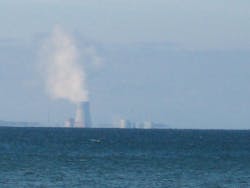The Empire State wants all-in on the next generation of nuclear power capacity.
New York Gov. Kathy Hochul has directed the statewide utility New York Power Authority to develop and build an advanced nuclear power plant in the upstate region. Nuclear energy reactors do not emit carbon dioxide and also operate with a higher capacity factor than even gas-fired or renewable energy facilities.
Small modular reactor (SMR) nuclear designs are envisioned by many power sector leaders as the key bridge between resiliency and sustainability given the rise of data centers, transportation and industrial electrification. The New York plan, however, is aiming squarely at utility-scale reactor technologies such as the Vogtle plant which expanded in Georgia earlier this decade.
“As New York State electrifies its economy, deactivates aging fossil fuel power generation and continues to attract large manufacturers that create good-paying jobs, we must embrace an energy policy of abundance that centers on energy independence and supply chain security to ensure New York controls its energy future,” Gov. Hochul said in a statement. “This is the second time during my administration that I am calling on the New York Power Authority to lead a critical energy initiative, and just as it is doing with the expedited buildout of renewable energy and transmission, it will now safely and rapidly deploy clean, reliable nuclear power for the benefit of all New Yorkers.”
The nation’s four most populous state may be heading into a grid power crisis due to economic growth and the retirement of numerous power plants over the past decade. The birthplace of utility-scale power generation, New York now generates nearly half of its grid electricity via natural gas, with about 20% of that coming via nuclear reactor units.
NYPA, in coordination with the Department of Public Service (DPS), will seek to develop at least one new nuclear energy facility with a combined capacity of no less than 1 GW of electricity, either alone or in partnership with private entities, to support the state's electric grid and the people and businesses that rely on it.
“Time and time again, the Power Authority has been called upon by New York State leadership to take bold action and we have delivered outcomes to support the public good,” Justin E. Driscoll, president and CEO of the NYPA, said. “I am honored by Governor Hochul’s confidence in NYPA to lead the buildout of the affordable and reliable clean energy economy of the future and we are eager to deliver on this impactful nuclear initiative for New Yorkers.”
New York has run four nuclear power plants statewide in this century, including Nine Mile Point (pictured), Fitzpatrick, Ginna and Indian Point. Ginna is scheduled for retirement later this decade while Indian Point was shut down several years ago.
NYPA will immediately begin evaluation of technologies, business models, and locations for this first nuclear power plant and will secure the key partnerships needed for the project. This process will include site and technology feasibility assessments as well as consideration of financing options, in coordination with the forthcoming studies included in the master plan for Responsible Advanced Nuclear Development in New York, led by the New York State Energy Research and Development Authority (NYSERDA) and DPS.
Among SMR nuclear companies currently working on federal approvals include NuScale Power, Terrestrial Energy, X-Energy, NANO Nuclear, Oklo and Kairos Power, among others.
Prospects for a Small, Modular and Reactive Future
Check out our free Microgrid Knowledge E-Book
About the Author
EnergyTech Staff
Rod Walton is senior editor for EnergyTech.com. He has spent 17 years covering the energy industry as a newspaper and trade journalist.
Walton formerly was energy writer and business editor at the Tulsa World. Later, he spent six years covering the electricity power sector for Pennwell and Clarion Events. He joined Endeavor and EnergyTech in November 2021.
He can be reached at [email protected].
EnergyTech is focused on the mission critical and large-scale energy users and their sustainability and resiliency goals. These include the commercial and industrial sectors, as well as the military, universities, data centers and microgrids.
Many large-scale energy users such as Fortune 500 companies, and mission-critical users such as military bases, universities, healthcare facilities, public safety and data centers, shifting their energy priorities to reach net-zero carbon goals within the coming decades. These include plans for renewable energy power purchase agreements, but also on-site resiliency projects such as microgrids, combined heat and power, rooftop solar, energy storage, digitalization and building efficiency upgrades.
